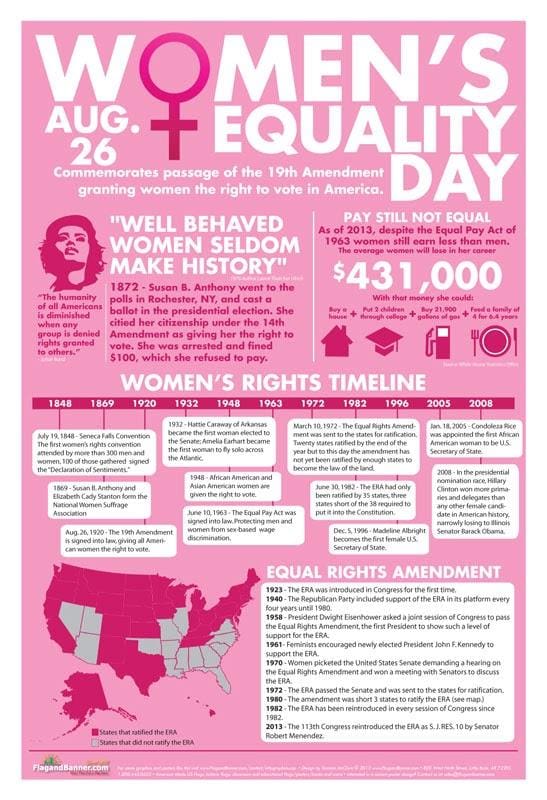Women’s Equality Day – Voting History
August 26, 2020
Voting History
Amy Lazet – CCS Digital Scholarship Specialist
August 26 is National Women’s Equality Day, and this year marks the 100th anniversary of the passing of the Nineteenth Amendment to the United States Constitution. This was the provision that allowed women to vote – previously, only men could vote – by stating that “the rights of citizens of the United States to vote shall not be denied or abridged by the United States or by any State on account of sex” (1). Voting has a long and storied history throughout the United States; in order to understand the importance of Women’s Equality Day and the significance of the right to vote, a brief recounting of the history of voting in the United States of America is necessary.
Background
Citizen voting started in the late 1770s in the U.S., but was restricted, namely to white men who owned land and were over the age of 21. Voting means that you have a say in who represents you in the government, making the right to vote an essential component of representative democracy. Furthermore, in 1787, the United States Constitutional Convention implemented the Three-Fifths Compromise, allowing owners of enslaved peoples to count each enslaved person as 3/5ths of a U.S. citizen. Slavery was hotly debated by members of the Convention, but the delegates from southern states realized that in order to uphold the institution of slavery, it was essential that they have greater representation (in terms of number of delegates in federal government) than the number of free members of the population justified. This continued to be the case until 1868 (2).
The Fourteenth Amendment was approved by Congress in 1866 and passed June 13, 1868, granting citizenship to “All persons born or naturalized in the United States.” This was brand-new; prior to this Amendment, enslaved people were not granted citizenship and were denied the rights that it entailed (3). In 1870, the Fifteenth Amendment was passed by Congress, stating that voting rights could not be “denied or abridged by the United States or by any state on account of race, color, or previous condition of servitude,” thereby granting Black men the right to vote (4). While this Amendment was passed on a federal level, it did not actually mean that all men, regardless of their race, had equal access to voting, simply that they had the right to vote. In practice, many African American men were denied the right to vote by Jim Crow laws, poll taxes, and literacy tests, in addition to voter intimidation and terrorization by groups like the KKK (5).
Women’s Suffrage
The history of women’s suffrage in the U.S. officially began in 1848, with the Seneca Falls Convention, where organizers proclaimed that women were created equal to men and had the “inalienable right to the elective franchise” (6). The organizers of the event formed two separate associations in 1869 to promote suffrage. Indeed, the more strident organization of the two (founded by Susan B. Anthony and Elizabeth Cady Stanton) opposed the Fifteenth Amendment for not including women (it addressed race but not gender). The other organization, unlike Anthony’s and Staton’s group, focused on the right to vote not on the federal level but rather in local and state elections (7).
Eventually, in 1890, the two groups merged to become the National American Woman Suffrage Association. This organization was also not without its problems, however, most notably related to a March 3, 1913 march of 5,000 women on Washington, D.C. The group at first attempted to exclude Black women but then, when that proved ineffective, segregate them during the rally. In 1917, the group arranged protests at the White House – standing silently outside nearly every day for almost three years. Many of these women were arrested and imprisoned; some went on hunger strikes and endured the torture of forced feedings while jailed. This treatment, meant to subdue the movement, actually made the group more sympathetic, gaining them additional supporters (7).
The Nineteenth Amendment, which was passed in 1920, had been introduced in every session of Congress for 42 years without gaining the necessary votes, but in 1919 it passed Congress: the House of Representatives by a vote of 304 to 90, the Senate, 56 to 25. The states, however, had to ratify the Amendment and it wasn’t until August of 1920 that Tennessee became the 36th state to do so, leading to its adoption on a federal level (7).
Combating Voter Disenfranchisement
While the passage of the Nineteenth Amendment was a monumental victory for women, in practice, it meant that white women were allowed to vote, but many Black women were prohibited from voting by the same means as Black men (Jim Crow laws, poll taxes, literacy tests, etc.). Eventually, in response, the Voting Rights Act of 1965, designed “to enforce the Fifteenth Amendment to the Constitution” was signed into law by President Lyndon Johnson (8). This was not achieved without extensive action by civil rights activists, many of whom suffered severe violence, inflicted in the south in 1964. This legislation mandated that literacy tests be abolished and required covered jurisdictions to obtain clearance before implementing any new voting practices and procedures. Finally, it also allowed the Attorney General to challenge poll taxes in state and local elections (federal elections had seen poll taxes abolished the previous year) (8).
For Native Americans, also known as American Indians, many states throughout history denied them the right to vote. Even after the passage of the 1924 citizenship bill, which granted Native Americans born in the U.S. full citizenship, states could still exercise the right to keep Native Americans from voting, often by provisions in their constitutions. It was only in 1962 that the last state, New Mexico, allowed Native Americans full access to the polls (9).
Nowadays
While much progress has been made in securing the right to vote for all, regardless of race or gender, many U.S. citizens are still denied the right to vote in a multitude of ways; for more information, see the ACLU’s Voter Suppression information.
References
“Transcript of 19th Amendment to the U.S. Constitution: Women’s Right to Vote (1920)”
“Constitutional compromises: The Three-Fifths Compromise”
“14th Amendment to the U.S. Constitution: Civil Rights (1868)”
“Transcript of 15th Amendment to the U.S. Constitution: Voting Rights (1870)”
“When Did African Americans Actually Get the Right to Vote?”
“History of women’s suffrage in the United States”
“Woman Suffrage and the 19th Amendment”
“Voting Rights Act (1965)”
“Voting Rights for Native Americans”

